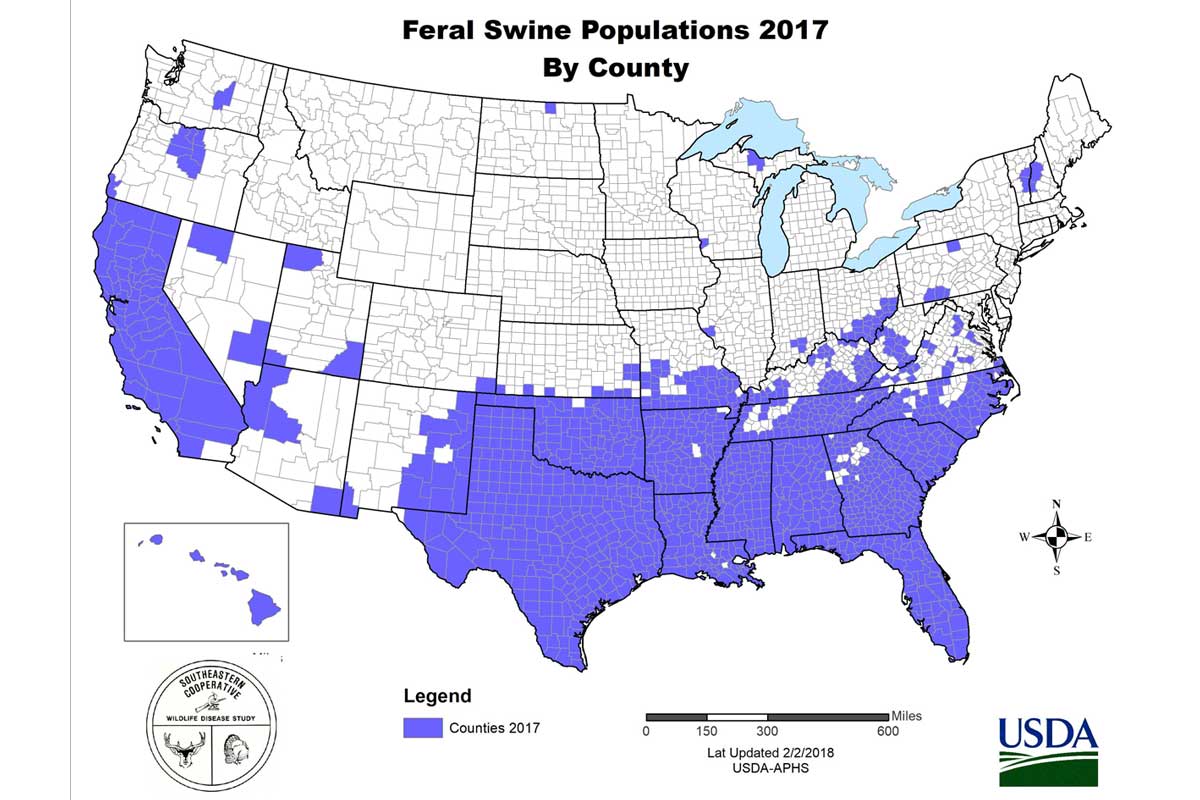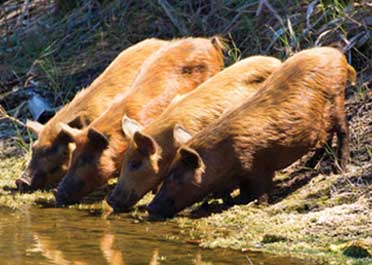African Swine Fever (ASF) is a hemorrhagic disease of pigs, warthogs, European wild boar and American feral pigs. ASF is highly contagious, and swine of all age groups are susceptible to it. Currently, there are no vaccines to prevent an outbreak, and ongoing outbreaks of ASF in several European Union countries – and the first-ever outbreak of the disease in China – has raised concerns among the veterinary medicine and animal disease research communities.
No one wants to unnecessarily cause panic in the US pork industry. However, some members of the research community say pork producers need to be vigilant and industry stakeholders should engage in a rational discussion about ASF prevention and preparedness.
A formidable foe
 Prof. James A. Roth, DVM, Ph.D., of the College of Veterinary Science at Iowa State Univ., says clinical signs of infection can vary from mild to 100 percent death rates in herds. Symptoms of infection can include high fever, loss of appetite and hemorrhages in the skin and internal organs. Death can occur within two to 10 days on average, according to the World Organization for Animal Health (OIE).
Prof. James A. Roth, DVM, Ph.D., of the College of Veterinary Science at Iowa State Univ., says clinical signs of infection can vary from mild to 100 percent death rates in herds. Symptoms of infection can include high fever, loss of appetite and hemorrhages in the skin and internal organs. Death can occur within two to 10 days on average, according to the World Organization for Animal Health (OIE).
ASF is a reportable disease listed in the Terrestrial Animal Health Code of the OIE. An outbreak of ASF in the United States would be devastating – unlike the Porcine Epidemic Diarrhea virus (PEDv), African Swine Fever would bring an immediate halt to US exports of pork products, Roth says.
“PED was terrible, but it was not listed as a foreign animal disease by the World Organization for Animal Health,” he says. “So, it didn’t shut down most of our exports, [but] African Swine Fever would, so that’s one big difference.”
Two other diseases could shut down US pork exports – foot-and-mouth disease, which affects livestock with hooves, and Classical Swine Fever which only affects pigs. There are vaccines for both of those diseases.
“African Swine Fever, there’s no vaccine anywhere in the world,” Roth explains. “Researchers have been working on it, but it’s a very difficult virus, and no one has succeeded in making a commercialized vaccine. So that means the only way to deal with African Swine Fever is to depopulate all the herds that are affected, and might be affected, in the area.”
Roth says the nature of the virus makes developing vaccines very difficult. “It’s really a unique virus; it’s the only one in its category,” he says. “Some viruses are easy to make vaccines against, some are very difficult. If you look at the AIDS virus, there’s been billions of dollars spent over the past 30 years and we still don’t have a vaccine.”
Vectors for transmission also present a challenge when it comes to eradicating the virus. ASF is transmissible via contaminated premises, vehicles, equipment and clothing. Warthogs can be a reservoir for the virus and show no clinical signs of infection.
Biting flies and ticks can transmit the disease by taking blood from an infected animal and passing on the virus to other susceptible animals.
OIE says pigs can become infected through direct contact with infected pigs because the virus can live in all body fluids and tissues of an infected animal. Garbage containing unprocessed infected pig meat also are vectors for transmission.
“It shows how stable this thing really is; there are many ways it’s going to move around. That’s why I’m worried about the fact that it’s now in China.” — Scott Dee
An especially troubling characteristic of this hardy virus is that it can survive in feed ingredients – including feed ingredients exported to the United States.
In 2014, Dr. Scott Dee, DVM, director of the Pipestone Veterinary Clinic in Pipestone, Minnesota, and his colleagues conducted research on the viability of PEDv in animal feed. “It was so intriguing that we thought ‘what about other viruses?’” he says. “That’s when we expanded it to the next phase and tested another 11 viruses under similar conditions.”
The researchers developed a model that uses representative situations to learn if a virus can survive a simulated ocean crossing in feed ingredients. The Trans-Pacific model simulated a journey starting in Beijing, then moving to Shanghai, on to San Francisco and ending in Des Moines, Iowa.
“We took different feed ingredients that we receive from China, and we ‘spiked’ those ingredients with a consistent amount of the virus, and we put those quantities into an environmental chamber which is like an incubator with a computer,” Dee explains. “You can program in variability in temperature and relative humidity and simulate a journey from China across the Pacific and then across the United States.”
Dee says characteristics of the ASF virus revealed in the model surprised him.
“It’s got a reputation to be very stable outside the host, so it can handle 60°C temperatures; it can handle high pH and low pH,” Dee says. “I knew it could be very stable, but in our model, we always include what we call a virus control which is the virus traveling on a similar journey by itself without any feed ingredient mixture.
“In all the other viruses we worked with, it didn’t survive in the absence of a feed matrix,” Dee notes. “They didn’t live by themselves in the containers we were using to simulate the journey. But African Swine Fever did; it was the only virus out of 12 that survived the journey in this virus control i.e. the virus alone in a container. That was really surprising because it was the only one that was able to do that.
“It shows how stable this thing really is; there are many ways it’s going to move around,” Dee adds. “That’s why I’m worried about the fact that it’s now in China.”
Deadly spread
China’s first outbreak of ASF occurred in Shenyang, the largest city in Liaoning Province. In that incident 47 pigs succumbed to the disease, and 8,069 pigs were culled. The China Animal Disease Control Centre, Veterinary Bureau, Ministry of Agriculture in Beijing reported the outbreak in March, but the OIE report states the outbreak started in January.
In response to the outbreak, the Chinese government implemented control measures that included movement control inside the country; surveillance outside containment and/or protection zones; screening; quarantine; official destruction of animal products; official disposal of carcasses, byproducts and waste; stamping out; control of wildlife reservoirs; zoning and disinfection.
Analysts tracking global pork markets predict ASF is within two months of spreading into Germany.
“The area extending 3 km from the edge of the outbreak site is designated as the epidemic zone,” the OIE report stated. “A total of 8,116 pigs have been killed and disposed of in the outbreak site and the epidemic zone at present, strict blockade, disinfection and movement control measures are continuing in the outbreak site and epidemic areas. A total of eight disinfection checkpoints have been established in the epidemic zone, all of the farms, backyards, and vehicles that enter and exit the epidemic areas must be disinfected. A comprehensive epidemiology investigation has been carried out in the whole Liaoning province, up until now, 1.88 million live pigs have been screened, no abnormal situation has been found.”
In a follow-up report, the Chinese government noted that the outbreak had been controlled, and no new cases of ASF had been detected. But within two weeks of that report, China announced two more outbreaks – one in the city of Zhengzhou and another in Lianyungang.
Some member states in the European Union also are struggling to contain the virus which continues to spread westward. Since January, outbreaks of ASF have occurred in domestic pigs and wild boar populations in the Czech Republic, Kaliningrad, Romania, Hungary and Poland, according to an outbreak assessment published in June by the Dept. for Environment, Food and Rural Affairs (Defra) in the United Kingdom.
Analysts tracking global pork markets predict ASF is within two months of spreading into Germany.
“As soon as it does hit Germany, Germany will get cut off from exports,” Christine McCracken, an executive director at Rabobank focusing on animal protein, said during a session of the Sosland Purchasing Seminar focusing on the status of the domestic and global protein markets.
For example, McCracken said exports of pork from Hungary came to a screeching halt after the virus swept through the country within two weeks and spread into Poland.
Stakeholders in the pork export business also are keeping tabs on the ASF outbreaks. André Nogueira, president and CEO, JBS USA Holdings, said during a discussion of second quarter earnings with analysts on Aug. 15, that an outbreak in Germany, The Netherlands and Denmark could have a big impact on their exports “…because normally, the markets will close the door, and that will open a big opportunity for the US. We’re not there yet; I’m not saying that this is going to happen, but this is something to pay attention to.”
In Defra’s assessment of Poland, the agency states, “There have been no further westward jumps in the last two months, but wild boar cases are still regularly reported in regions bordering Kaliningrad in the north and in the regions around the city of Warsaw.”
There have been more than 1,450 cases of ASF in wild boar reported in Poland so far in 2018.
“Following epidemiological investigations, possible sources of infection have been identified as poor compliance with biosecurity rules and suspicion of illegal pig movements,” according to the report. “There has been no recent trade in live pigs from Poland to the UK. Biosecurity awareness has been increased within the wider disease control zone and efforts are now concentrating on public awareness campaigns aimed at hunter and border controls.”
Defra concluded that the risk of ASF introduction to the UK is still considered to be low, but the risk is showing no signs of decreasing. There could be a risk involving vehicle traffic and movement of people from affected Eastern EU countries in light of evidence of contaminated non-EU origin pork products detected in the EU.
Avenues for introduction

The United States currently is ASF-free. But researchers with the Animal and Plant Health Inspection Service (APHIS) of the US Dept. of Agriculture published a review of vulnerabilities that could lead to the introduction of ASF to the US.
In an article published in Frontiers in Veterinary Science in February, the authors, Vienna R. Brown and Sarah N. Bevins identified legal and illegal movement of live animals, legal and illegal movement of feed, animal products and byproducts; and bioterrorism as vulnerabilities.
The illegal importation of livestock products also puts the US at risk for the introduction of African Swine Fever, according to the review. Citing data provided by Customs and Border Protection (CBP) of the US Dept. of Homeland Security, more than 68,000 products and specimens derived from domestic swine were confiscated by CBP between 2012 and 2016.
“The continents of origin for the majority of products and specimens confiscated by CBP are Asia and Europe, which comprise 49 and 44 percent of the confiscations, respectively,” the authors wrote. South America, Australia, Africa, and unknown account for ≤1 percent each, and products and specimens confiscated from North America comprise 5 percent.”
In 2017, the GAO reported that wildlife trafficking generates an estimated $7 billion to $23 billion annually. Illegal trade in wildlife continues to push some protected and endangered animal species to the brink of extinction.
The authors also identified as a problem the illegal importation of warthog products. The US Fish and Wildlife Service (FWS) oversees confiscation of illegally imported wildlife. However, the authors cited a 1994 report from the General Accountability Office which estimated that 1 percent to 3 percent of illegal wildlife shipments carried by passengers and between 1 percent and 10 percent of illegally imported wildlife in declared cargo shipments are detected.
“Warthog products are responsible for more than 60 percent of confiscations followed by wild boar, bush pigs, unspecified swine products, and babirusa; however, the sample size is small because of the specific nature of the data and because not all illegal imports are likely to be detected,” the authors wrote.
Finally, ASF is a potential weapon for use in a bioterrorist attack. Bevins and Brown said the value of the US pork industry; ease of viral spread, the stability of the virus outside of a host; the safety of the individuals releasing the virus (it only affects pigs); and the devastating economic impact of an outbreak in the US swineherd are factors that make ASF attractive to terrorists.
What happens next?
The main line of defense against ASF is rapid detection, Roth says. Currently, there is no active surveillance for ASF going on, but there is awareness among producers that they should immediately call their veterinarian if they see something unusual in their herds.
If the veterinarian sees something unusual – even if they just suspect African Swine Fever or Classical Swine Fever or foot-and-mouth – they need to call the state veterinarian or USDA veterinarian in their state.
call the state veterinarian or USDA veterinarian in their state.
Roth says “…they will send out trained foreign animal disease diagnosticians – veterinarians that have taken the course and are certified as foreign animal disease diagnosticians. They’re located throughout the United States; every state has several of them, and they can be there within a few hours. They know how to take the samples and where to submit them, usually to Plum Island. A few state labs have the capacity to diagnose ASF, but all diagnoses must be confirmed at PlumIsland.
“The main thing we need with African Swine Fever is more investment in the diagnostic labs so that they’re all ready to diagnose it,” Roth adds, “and then surge capacity, because if we do have a case of any of those three diseases, there will immediately be a need for hundreds of thousands of tests.”
Another focus of research should include soft ticks, which can transmit the virus. “We do have soft ticks in the US that are different than the ones in Africa that have been studied a lot,” Roth explains. “There needs to be research on those soft ticks that we have to determine how many of those could transmit the virus. But if it gets into feral swine – even without ticks – it will be very, very difficult to eradicate.”
The USDA estimates the feral swine population in the US at 6 million. According to the agency, the animals were brought to the US in 1500s as a source of food, but “free-range” livestock management and escapes from pens led to the first established population of feral swine. Eurasian or Russian wild boars were introduced into parts of the US for sport hunting. USDA says that today, feral swine are a combination of escaped domestic pigs, Eurasian wild boars and hybrids of the two breeds.
“You don’t want to cause a panic, but I think we have to be aware, and maybe start talking about, possible ways we can manage this in a controlled setting. We’ve got to keep our cool, look at the science and start talking about what else do we need to do.” — Scott Dee
In response to the problem, USDA launched a feral swine management program in 2014. At a cost of $20 million, the Wildlife Services (WS) program of APHIS, among other initiatives, enhanced testing of feral swine for Classical Swine Fever, swine brucellosis, porcine reproductive and respiratory syndrome, swine influenza and pseudorabies.
Control of feral swine populations in the US is crucial. “The feral hogs are already a problem,” Roth says. “If this virus gets into the feral swine in the southern parts of the US where they’re really prevalent, it will be nearly impossible to eradicate – even without the ticks.”
Dee says producers should become familiar with current studies of ASF and continue supporting agencies that are researching mitigation strategies. He says raising awareness about products the US imports from high-risk countries should be considered.
“I think before we started this project, no one was aware of the volume of the products coming in from countries that have a different health status than ours,” Dee says.
“You don’t want to cause a panic, but I think we have to be aware, and maybe start talking about, possible ways we can manage this in a controlled setting,” he concludes. “We’ve got to keep our cool, look at the science and start talking about what else do we need to do.”

